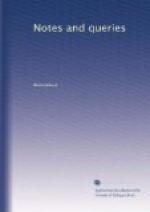June 19.
* * * * *
THE HYDRO-INCUBATOR.
Most, if not all, of your readers have heard of the newly-invented machine for hatching and rearing in chickens, without the maternal aid of the hen; probably many of them have paid a visit (and a shilling) at No. 4. Leicester Square, where the incubator is to be seen in full operation. The following extract will, therefore, be acceptable, as it tends to show the truth of the inspired writer’s words, “There is no new thing under the sun:”—
“Therefore ... it were well we made our remarks in some creatures, that might be continually in our power, to observe in them the course of nature, every day and hour. Sir John Heydon, the Lieutenant of his Majesties Ordnance (that generous and knowing gentleman and consummate souldier, both in theory and practice) was the first that instructed me how to do this, by means of a furnace, so made as to imitate the warmth of a sitting hen. In which you may lay several eggs to hatch and by breaking them at several ages, you may distinctly observe every hourly mutation in them, if you please. The first will be, that on one side you shall find a great resplendent clearness in the white. After a while, a little spot of red matter, like blood will appear in the midst of that clearness, fast’ned to the yolk, which will have a motion of opening and shutting, so as sometimes you will see it, and straight again it will vanish from your sight, and indeed, at first it is so little that you cannot see it, but by the motion of it; for at every pulse, as it opens you may see it, and immediately again it shuts, in such sort as it is not to be discerned. From this red speck, after a while, there will stream out a number of little (almost imperceptible) red veins. At the end of some of which, in time, there will be gathered together a knot of matter, which by little and little will take the form of a head and you will, ere long, begin to discern eyes and a beak in it. All this while the first red spot of blood grows bigger and solider, till at length it becomes {85} a fleshy substance, and, by its figure, may easily be discern’d to be the heart; which as yet hath no other inclosure but the substance of the egg. But by little and little, the rest of the body of an animal is framed out of those red veins which stream out all about from the heart. And in process of time, that body encloses the heart within it by the chest, which grows over on both sides, and in the end meets and closes itself fast together. After which this little creature soon fills the shell, by converting into several parts of itself all the substance of the egg; and then growing weary of so strait a habitation, it breaks prison and comes out a perfectly formed chicken.”—Sir Kenelm Digby’s Treatise of Bodies, Ch. xxiv. p. 274. ed. 1669.
Could Sir Kenelm return to the scenes of this upper world, and pay a visit to Mr. Cantelo’s machine, his shade might say with truthfulness, what Horace Smith’s mummy answered to his questioner,—




